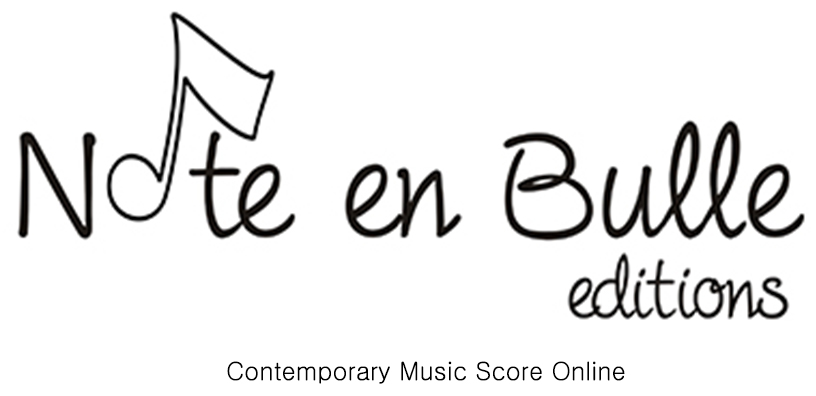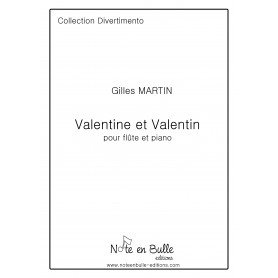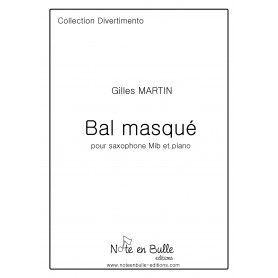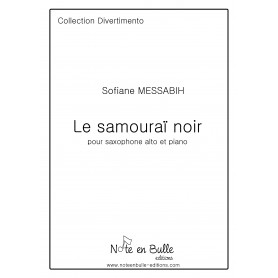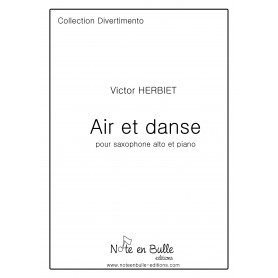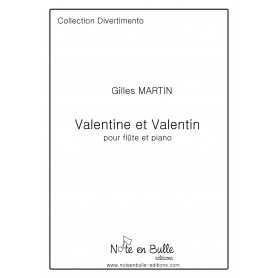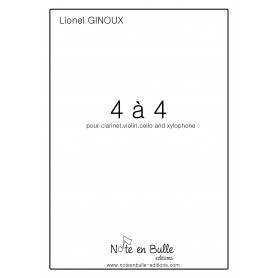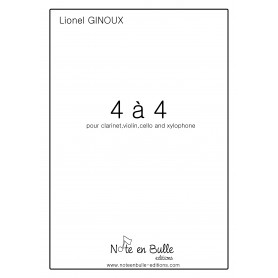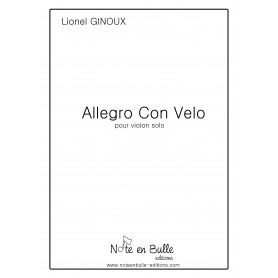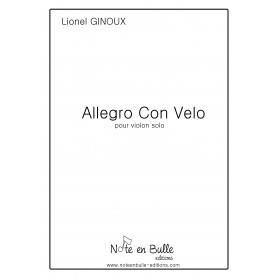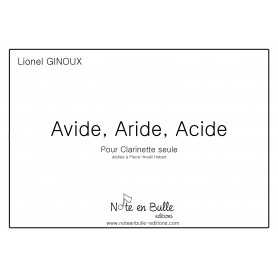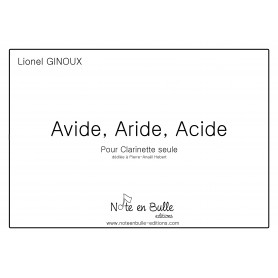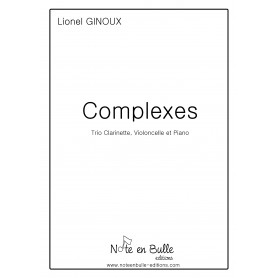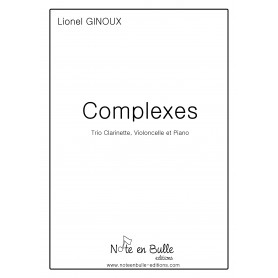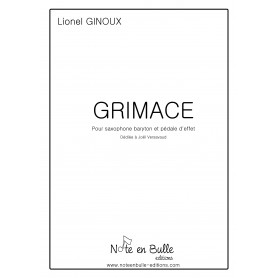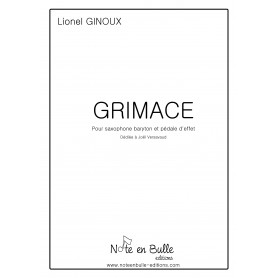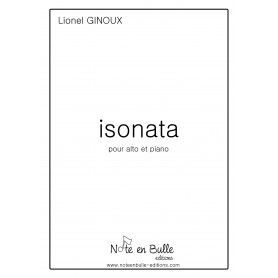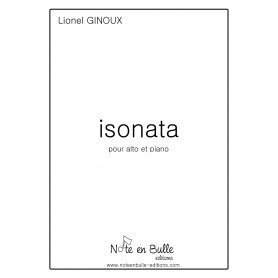Lionel Ginoux
There are 37 products.
Lionel Ginoux 4 à 4 - pdf
Version PDF
4 à 4
Clarinet, Violin, Cello and Xylophone
Duration 4'30
4 à 4 reveals multiple instrumental timbres and colors and also different techniques of attack: air and breath for the clarinet, the bowing of the violin and cello, and the percussive sound and distinct and precise attack of the xylophone. The four instruments mix perfectly in polyphony with homorhythmic passages, allowing surprising sonorities to spring forth.
Printed paper, click here
4 à 4
Clarinet, Violin, Cello and Xylophone
Duration 4'30
4 à 4 reveals multiple instrumental timbres and colors and also different techniques of attack: air and breath for the clarinet, the bowing of the violin and cello, and the percussive sound and distinct and precise attack of the xylophone. The four instruments mix perfectly in polyphony with homorhythmic passages, allowing surprising sonorities to spring forth.
Printed paper, click here
15.00
Lionel Ginoux 4 à 4 Version papier
4 à 4
Clarinet, Violin, Cello and Xylophone
Duration 4'30
4 à 4 reveals multiple instrumental timbres and colors and also different techniques of attack: air and breath for the clarinet, the bowing of the violin and cello, and the percussive sound and distinct and precise attack of the xylophone. The four instruments mix perfectly in polyphony with homorhythmic passages, allowing surprising sonorities to spring forth.
Clarinet, Violin, Cello and Xylophone
Duration 4'30
4 à 4 reveals multiple instrumental timbres and colors and also different techniques of attack: air and breath for the clarinet, the bowing of the violin and cello, and the percussive sound and distinct and precise attack of the xylophone. The four instruments mix perfectly in polyphony with homorhythmic passages, allowing surprising sonorities to spring forth.
30.00
Lionel Ginoux Allegro con velo - pdf
PDF download
Allegro con velo
Violin
Durée 05'00
From a double string opening, a gentle and languorous oriental melody emerges with an Allegro tempo. This transforms into singing melismas that swirl among warm oriental colors before returning to their original state of a double string melody.
Printed version, click here
Allegro con velo
Violin
Durée 05'00
From a double string opening, a gentle and languorous oriental melody emerges with an Allegro tempo. This transforms into singing melismas that swirl among warm oriental colors before returning to their original state of a double string melody.
Printed version, click here
7.00
Lionel Ginoux Allegro con velo - sheet paper
Allegro con velo
Violin
Durée 05'00
From a double string opening, a gentle and languorous oriental melody emerges with an Allegro tempo. This transforms into singing melismas that swirl among warm oriental colors before returning to their original state of a double string melody.
Violin
Durée 05'00
From a double string opening, a gentle and languorous oriental melody emerges with an Allegro tempo. This transforms into singing melismas that swirl among warm oriental colors before returning to their original state of a double string melody.
16.00
Lionel Ginoux Avide, Aride, Acide - pdf
PDF download
Avide, Aride, Acide
Clarinet
Duration 13'00
Avide, Aride, Acide: three words, three characters, with only one change of letter. Avide is an image of a molecule moving in the human body, an incessant quintuplet movement, which takes sudden musical changes.Aride is the desert, a desert of notes (six notes). A work on the timbre and expressiveness of the instrument.Acid is the bitterness of taste. The high-pitch register of the clarinet can disturb the perception of the ear.
Audio
Printed version, click here
Avide, Aride, Acide
Clarinet
Duration 13'00
Avide, Aride, Acide: three words, three characters, with only one change of letter. Avide is an image of a molecule moving in the human body, an incessant quintuplet movement, which takes sudden musical changes.Aride is the desert, a desert of notes (six notes). A work on the timbre and expressiveness of the instrument.Acid is the bitterness of taste. The high-pitch register of the clarinet can disturb the perception of the ear.
Audio
Printed version, click here
10.00
Lionel Ginoux Avide, Aride, Acide - sheet paper
Avide, Aride, Acide
Clarinet
Duration 13'00
Avide, Aride, Acide: three words, three characters, with only one change of letter. Avide is an image of a molecule moving in the human body, an incessant quintuplet movement, which takes sudden musical changes.Aride is the desert, a desert of notes (six notes). A work on the timbre and expressiveness of the instrument.Acid is the bitterness of taste. The high-pitch register of the clarinet can disturb the perception of the ear.
Audio
Clarinet
Duration 13'00
Avide, Aride, Acide: three words, three characters, with only one change of letter. Avide is an image of a molecule moving in the human body, an incessant quintuplet movement, which takes sudden musical changes.Aride is the desert, a desert of notes (six notes). A work on the timbre and expressiveness of the instrument.Acid is the bitterness of taste. The high-pitch register of the clarinet can disturb the perception of the ear.
Audio
17.00
Lionel Ginoux Complexes - Version papier
Complexes
Clarinet, Cello and Piano
Duration 05'00
Complexes is a composition born from the pictorial grammar Kandinsky used in the painting Two complexes. The concept is to structure the piece and to construct musical substance according to the three pictorial elements of the painting: the dot, the line and the curve.The dot is a cluster, a static compact sound object.The line is born from movement and is dynamic.The curve is represented by appoggiaturas that, like luminous flashes, represent a movement in circles.
Clarinet, Cello and Piano
Duration 05'00
Complexes is a composition born from the pictorial grammar Kandinsky used in the painting Two complexes. The concept is to structure the piece and to construct musical substance according to the three pictorial elements of the painting: the dot, the line and the curve.The dot is a cluster, a static compact sound object.The line is born from movement and is dynamic.The curve is represented by appoggiaturas that, like luminous flashes, represent a movement in circles.
30.00
Lionel Ginoux Complexes - Version PDF
PDF download
Complexes
Clarinet, Cello and Piano
Duration 05'00
Complexes is a composition born from the pictorial grammar Kandinsky used in the painting Two complexes. The concept is to structure the piece and to construct musical substance according to the three pictorial elements of the painting: the dot, the line and the curve.The dot is a cluster, a static compact sound object.The line is born from movement and is dynamic.The curve is represented by appoggiaturas that, like luminous flashes, represent a movement in circles.
Audio
Printed Version, Click here
Complexes
Clarinet, Cello and Piano
Duration 05'00
Complexes is a composition born from the pictorial grammar Kandinsky used in the painting Two complexes. The concept is to structure the piece and to construct musical substance according to the three pictorial elements of the painting: the dot, the line and the curve.The dot is a cluster, a static compact sound object.The line is born from movement and is dynamic.The curve is represented by appoggiaturas that, like luminous flashes, represent a movement in circles.
Audio
Printed Version, Click here
15.00
Lionel Ginoux Grimace
PDF download
Grimace
Baryton Saxophone and Effects Pedal (or wave file)
durée 07'
Play on timbre and improvised sounds? Virtuoso piece? Work on spontaneity, energy. The musician's presence. A music on the beat? Shifts ...Or even luminous flashes, sparkles of sound, random trajectories.And then? Tension, silence … Dedicated to Joël Versavaud, performed for the first time in October 2005, by Quid Novi in Avignon
Printed Version, click here
Grimace
Baryton Saxophone and Effects Pedal (or wave file)
durée 07'
Play on timbre and improvised sounds? Virtuoso piece? Work on spontaneity, energy. The musician's presence. A music on the beat? Shifts ...Or even luminous flashes, sparkles of sound, random trajectories.And then? Tension, silence … Dedicated to Joël Versavaud, performed for the first time in October 2005, by Quid Novi in Avignon
Printed Version, click here
15.00
Lionel Ginoux Grimace - Sheet paper
Sheet paper
Grimace
Baryton Saxophone and Effects Pedal (or wave file)
durée 07'
Play on timbre and improvised sounds? Virtuoso piece? Work on spontaneity, energy. The musician's presence. A music on the beat? Shifts ...Or even luminous flashes, sparkles of sound, random trajectories.And then? Tension, silence … Dedicated to Joël Versavaud, performed for the first time in October 2005, by Quid Novi in Avignon
Grimace
Baryton Saxophone and Effects Pedal (or wave file)
durée 07'
Play on timbre and improvised sounds? Virtuoso piece? Work on spontaneity, energy. The musician's presence. A music on the beat? Shifts ...Or even luminous flashes, sparkles of sound, random trajectories.And then? Tension, silence … Dedicated to Joël Versavaud, performed for the first time in October 2005, by Quid Novi in Avignon
22.00
Lionel Ginoux Isonata - pdf
Version PDF
isonata
Viola and Piano
duration 17'
Work dedicated to Jérémie Honnoré. Commissioned by the Festival Musique à la Ferme (2014).The starting point for this piece is my passion for the viola and the desire to write a piece for this instrument. The viola therefore has an important role. It takes a special place in this score. The piano "colours" the viola's voice and increases its dramatic intensity.With isonata, I wanted to return not to the known forms of the classical sonata, but to return to the starting point of the creation of this form which was: "to provide instrumental music with a musical equivalent to dramatic action (as in the opera or the concerto) by giving a clear definition of the outline of this action (an easily identifiable climax, a point of maximum tension towards which the parts converge...)". (Charles Rosen). I started from this idea of contrast of musical material, of clarity of form, in order to knead the "classical" sonata form.In isonata, musically my postulate was to superimpose consonant chords (left hand three sound chord, right hand three sound chord) and to use repetition and resonance in order to cut the temporal markers and to work on the musical flow. From these two principles, I created the form and the tension/relaxation of the score by stacking or subtracting musical material.I then increased the title "sonata" of the "i" which is nowadays perhaps an emblematic letter with the iphone, ipad, imac... I thought that this could make sense with modernity. This letter "i" asked me the question, in my creation, of memory and especially of the fact that our knowledge is now dependent on hard disks or other storage devices. We entrust our knowledge and understanding to our machines. This is disturbing because we now learn more to seek than to remember. Aren't memory and language gradually being anaesthetized in favour of our machines? That's a bit like that in this room. The language in isonata is as if atrophied, but it keeps all its strength and power.
Printed version,click here
isonata
Viola and Piano
duration 17'
Work dedicated to Jérémie Honnoré. Commissioned by the Festival Musique à la Ferme (2014).The starting point for this piece is my passion for the viola and the desire to write a piece for this instrument. The viola therefore has an important role. It takes a special place in this score. The piano "colours" the viola's voice and increases its dramatic intensity.With isonata, I wanted to return not to the known forms of the classical sonata, but to return to the starting point of the creation of this form which was: "to provide instrumental music with a musical equivalent to dramatic action (as in the opera or the concerto) by giving a clear definition of the outline of this action (an easily identifiable climax, a point of maximum tension towards which the parts converge...)". (Charles Rosen). I started from this idea of contrast of musical material, of clarity of form, in order to knead the "classical" sonata form.In isonata, musically my postulate was to superimpose consonant chords (left hand three sound chord, right hand three sound chord) and to use repetition and resonance in order to cut the temporal markers and to work on the musical flow. From these two principles, I created the form and the tension/relaxation of the score by stacking or subtracting musical material.I then increased the title "sonata" of the "i" which is nowadays perhaps an emblematic letter with the iphone, ipad, imac... I thought that this could make sense with modernity. This letter "i" asked me the question, in my creation, of memory and especially of the fact that our knowledge is now dependent on hard disks or other storage devices. We entrust our knowledge and understanding to our machines. This is disturbing because we now learn more to seek than to remember. Aren't memory and language gradually being anaesthetized in favour of our machines? That's a bit like that in this room. The language in isonata is as if atrophied, but it keeps all its strength and power.
Printed version,click here
15.00
Lionel Ginoux Isonata - Printed Version
isonata
Viola and Piano
duration 17'
Work dedicated to Jérémie Honnoré. Commissioned by the Festival Musique à la Ferme (2014).The starting point for this piece is my passion for the viola and the desire to write a piece for this instrument. The viola therefore has an important role. It takes a special place in this score. The piano "colours" the viola's voice and increases its dramatic intensity.With isonata, I wanted to return not to the known forms of the classical sonata, but to return to the starting point of the creation of this form which was: "to provide instrumental music with a musical equivalent to dramatic action (as in the opera or the concerto) by giving a clear definition of the outline of this action (an easily identifiable climax, a point of maximum tension towards which the parts converge...)". (Charles Rosen). I started from this idea of contrast of musical material, of clarity of form, in order to knead the "classical" sonata form.In isonata, musically my postulate was to superimpose consonant chords (left hand three sound chord, right hand three sound chord) and to use repetition and resonance in order to cut the temporal markers and to work on the musical flow. From these two principles, I created the form and the tension/relaxation of the score by stacking or subtracting musical material.I then increased the title "sonata" of the "i" which is nowadays perhaps an emblematic letter with the iphone, ipad, imac... I thought that this could make sense with modernity. This letter "i" asked me the question, in my creation, of memory and especially of the fact that our knowledge is now dependent on hard disks or other storage devices. We entrust our knowledge and understanding to our machines. This is disturbing because we now learn more to seek than to remember. Aren't memory and language gradually being anaesthetized in favour of our machines? That's a bit like that in this room. The language in isonata is as if atrophied, but it keeps all its strength and power.
Viola and Piano
duration 17'
Work dedicated to Jérémie Honnoré. Commissioned by the Festival Musique à la Ferme (2014).The starting point for this piece is my passion for the viola and the desire to write a piece for this instrument. The viola therefore has an important role. It takes a special place in this score. The piano "colours" the viola's voice and increases its dramatic intensity.With isonata, I wanted to return not to the known forms of the classical sonata, but to return to the starting point of the creation of this form which was: "to provide instrumental music with a musical equivalent to dramatic action (as in the opera or the concerto) by giving a clear definition of the outline of this action (an easily identifiable climax, a point of maximum tension towards which the parts converge...)". (Charles Rosen). I started from this idea of contrast of musical material, of clarity of form, in order to knead the "classical" sonata form.In isonata, musically my postulate was to superimpose consonant chords (left hand three sound chord, right hand three sound chord) and to use repetition and resonance in order to cut the temporal markers and to work on the musical flow. From these two principles, I created the form and the tension/relaxation of the score by stacking or subtracting musical material.I then increased the title "sonata" of the "i" which is nowadays perhaps an emblematic letter with the iphone, ipad, imac... I thought that this could make sense with modernity. This letter "i" asked me the question, in my creation, of memory and especially of the fact that our knowledge is now dependent on hard disks or other storage devices. We entrust our knowledge and understanding to our machines. This is disturbing because we now learn more to seek than to remember. Aren't memory and language gradually being anaesthetized in favour of our machines? That's a bit like that in this room. The language in isonata is as if atrophied, but it keeps all its strength and power.
22.00
